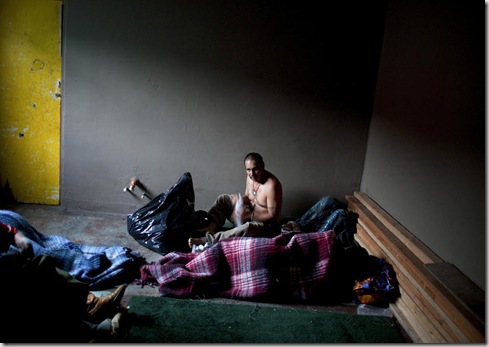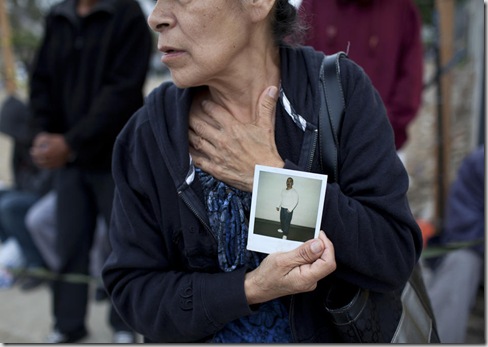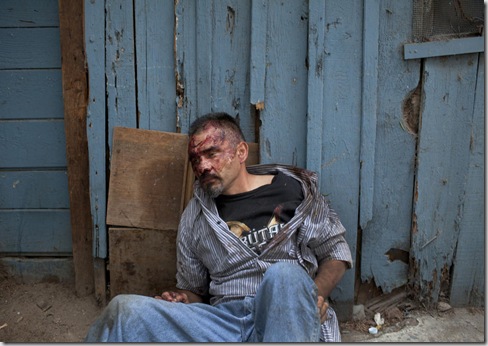They present an enormous challenge to American policymakers, because they continue to head north despite obstacles more severe than at any time in recent history. It is not just that the American economy has little to offer; the border itself is far more threatening. On one side, fences have grown and American agents have multiplied; on the other, criminals haunt the journey at every turn.
Fifty-six percent of apprehensions at the Mexican border in 2010 involved people who had been caught previously, up from 44 percent in 2005. A growing percentage of deportees in recent years have also been deported before, according to Department of Homeland Security figures.

A man looks around a border fence that separates Mexico from the U.S., which will be replaced with a more modern fence, harder to scale, in Nogales, Mexico, the largest Mexican city bordering Arizona, June 20, 2011. Migrant shelters along the Mexican border are filled not with newcomers looking for a better life, but with seasoned crossers: older men and women, often deportees, braving ever-greater risks to get back to their families in the U.S., the country they consider home. (Tyler Hicks/The New York Times)

A U.S. Customs and Border Protection vehicle patrols across the border from Nogales, the largest Mexican city bordering Arizona, June 18, 2011. (Tyler Hicks/The New York Times)

A group of men in Nogales, the largest Mexican city bordering Arizona, June 18, 2011. (Tyler Hicks/The New York Times)

A man sleeps at a shelter in Tijuana, Mexico, Aug. 13, 2011. Migrant shelters along the Mexican border are filled not with newcomers looking for a better life, but with seasoned crossers: older men and women, often deportees, braving ever-greater risks to get back to their families in the U.S., the country they consider home. (Tyler Hicks/The New York Times)

The Rivera-Ramirez family of six, with four girls and two boys were deported from the U.S., in Tijuana, Mexico, Aug. 11, 2011. (Tyler Hicks/The New York Times)

A bus waits for passengers near a border wall in Nogales, the largest Mexican city bordering Arizona. (Tyler Hicks/The New York Times)

A man rests against a barbed wire line up while waiting for food in Tijuana, Mexico, Aug. 11, 2011. Migrant shelters along the Mexican border are filled not with newcomers looking for a better life, but with seasoned crossers: older men and women, often deportees, braving ever-greater risks to get back to their families in the U.S., the country they consider home. (Tyler Hicks/The New York Times)

A man gets a trim near a dry canal along the U.S. border in Tijuana, Mexico, Aug. 10, 2011. (Tyler Hicks/The New York Times)

A man smokes marijuana along a fence in Nogales, the largest Mexican city bordering Arizona, June 18, 2011. (Tyler Hicks/The New York Times)

A man at a shelter in Tijuana, Mexico, Aug. 13, 2011. Migrant shelters along the Mexican border are filled not with newcomers looking for a better life, but with seasoned crossers: older men and women, often deportees, braving ever-greater risks to get back to their families in the U.S., the country they consider home. (Tyler Hicks/The New York Times)

Men wait in a dry canal along the U.S. and Mexico border, mostly full of homeless deportees, in Tijuana, Mexico, Aug. 12, 2011. (Tyler Hicks/The New York Times)

Irma Villeda wanders up and down a food line displaying a photograph of her son, George Villeda, a missing deportee, in Tijuana, Mexico, Aug. 11, 2011. Border crossers are braving ever-greater risks to get back to their families in the U.S., the country they consider home. (Tyler Hicks/The New York Times)

A woman looks on at a man who lays beaten in an alley near the U.S. border in Tijuana, Mexico, Aug. 14, 2011. Migrant shelters along the Mexican border are filled not with newcomers looking for a better life, but with seasoned crossers: older men and women, often deportees, braving ever-greater risks to get back to their families in the U.S., the country they consider home. (Tyler Hicks/The New York Times)

A man who has been beaten in an alley next to the border, in Tijuana, Mexico, Aug. 14, 2011. Migrant shelters along the Mexican border are filled not with newcomers looking for a better life, but with seasoned crossers: older men and women, often deportees, braving ever-greater risks to get back to their families in the U.S., the country they consider home. (Tyler Hicks/The New York Times)

A man stands near a fence that separates Mexico from the U.S. that will be replaced with a more modern fence, one harder to scale, in hopes of finding scrap metal to sell, in Nogales, Mexico, the largest Mexican city bordering Arizona, June 20, 2011. (Tyler Hicks/The New York Times)

A line forms early for free food next to a migrant shelter in Tijuana, Mexico, Aug. 14, 2011. (Tyler Hicks/The New York Times)

The border fence at the beach in Tijuana, Mexico, Aug. 11, 2011. Migrant shelters along the Mexican border are filled not with newcomers looking for a better life, but with seasoned crossers: older men and women, often deportees, braving ever-greater risks to get back to their families in the U.S., the country they consider home. (Tyler Hicks/The New York Times)

Beach-goers stand by a fence along the California border in Tijuana, Mexico, Aug. 11, 2011. (Tyler Hicks/The New York Times)

Two people embrace in the desert in Ciudad Juarez, Mexico, May 28, 2011. (Tyler Hicks/The New York Times)
Fonte

Nessun commento:
Posta un commento